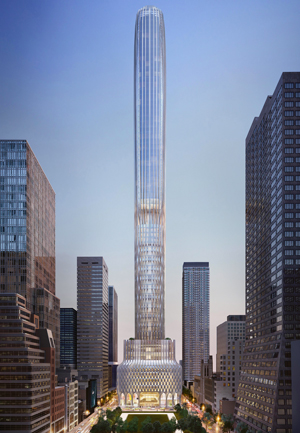Trending
Hadid’s tower of hubris isn’t half bad
The late architect’s skyscraper would be an improvement for Midtown — if it were ever built

To say that Zaha Hadid’s [TRDataCustom] recently revealed designs for 666 Fifth Avenue may never be built is, of course, an understatement, lending an air of reality to a project that has essentially no grounding in it.
The late architect’s drawings, commissioned by the Kushner Companies shortly before her death, show a high-concept monument that would replace the site’s 41-story tower with an 80-story superluxe skyscraper — securing, in the process, the Kushners’ increasingly tenuous hold on the shining trophy that announced their ascendance from New Jersey developers to Manhattan big shots. (The overleveraged deal also happens to be presidential son-in-law Jared Kushner’s main claim to real estate prowess.)
The obstacles, of course, are many. The most substantive being the dearth of investors willing to pay for a trophy tower at a time when half a dozen such projects have been abandoned as unviable. And time, in this case, is very much of the essence. As was recently noted in the New York Times, Kushner needs to “bring in a fresh infusion of cash or a well-heeled partner willing to foot the bill, if it wants to hold on to the building.”
In recent years, the building has failed to produce enough income to pay its debts, according to the Times, with the owners filling the ever-widening shortfall from their own pockets. More ominously, the interest-only $1.2 billion mortgage is scheduled to come due in less than two years. Earlier this year, it looked like Anbang Insurance Group, the Chinese company that bought the Waldorf Astoria, might come to the Kushners’ rescue, but Anbang ultimately walked away. Another investor has yet to emerge.
In the event that one does, the plan is to raze the existing structure and, following the model of other recent supertall buildings, rebuild it as a mixed-use space with most of the upper floors given over to residential condos and, on the lower levels, a hotel, office space and retail.
The Kushners also intend to change the name and address of the building to 660 Fifth Avenue. Allegedly, this new structure would be worth an unheard-of $12 billion, including the residential condos.

Zaha Hadid
Though major alterations to the existing 666 Fifth are highly unlikely to happen, few New Yorkers would shed tears if they did. Designed by Carson & Lundin and completed in 1957 by Tishman Realty and Construction, 666 Fifth Avenue represents the stale butt-end of the International Style that recast Midtown during the postwar years. True, the Seagram Building, the unrivaled masterpiece of the style, would not be completed for another four years, but 666 Fifth reveals how the style had been all but exhausted by the time it came along.
The best thing to be said for this pale, silvery tower is that it is easily overlooked amid the welter of similar buildings in the area. Rising 40 stories on a 10-story base, it is made up of alternating lines of ribbon windows and infill formed by embossed aluminum panels. A product of the “Mad Men” era, the original design had, typically, sculptures by Isamu Noguchi in the lobby and, in the penthouse, the once-famous Top of the Sixes restaurant, operated by Stouffer’s, no less. Also typically, there was a bookstore in the lobby (there used to be half a dozen bookstores along this part of Fifth) and an Alitalia office, recalling a time when Midtown was the place to buy tickets from all the major airlines.
In some ways, the Hadid tower is just as typical of our current era, aspiring to be one of the tallest new buildings to invade this stretch of Midtown. But it is not a typical building to come out of the late architect’s workshop. Hadid specialized in museums, cultural centers and infrastructure projects, resulting in decidedly horizontal designs conceived in the tumultuous and irregular idiom of the Deconstructivist style. By contrast, 660 Fifth is a decidedly vertical building, and an oddly conventional one as well, at least in that it largely avoids the architect’s signature asymmetries.
The tall shaft rises in a regular manner above the sort of base that has been such standard fare in Midtown since the completion of Lever House in 1953 that one wonders if the architect was indulging in a bit of contextualism, even historicism.
The main selling point of the project is its surface treatment, and in this respect Hadid is in lockstep with other mainstream contemporary architects such as Steven Holl and Herzog & de Meuron, who similarly emphasize surface treatment as the main vector of meaning and interest, rather than volume and form, favored by earlier architects. Indeed, the way the building stacks up along the sides to form a strict, almost tyrannical symmetry feels almost like a polemic in its rejection of the irregularities of the architect’s earlier work.
When it comes to the surface treatment, Hadid exhibited a strong tendency toward improvisation, seemingly selecting shapes and patterns as the mood took her. At street level, for example, she decided to articulate the surface with rows of arched windows that recall the Catalan arches of Antoni Gaudí. These arches span two or more stories. Above is a six-story cluster of dense honeycombs that slightly cantilever over the street-level area. This is surmounted by a recessed and far more regular two-story box whose curtain wall is articulated by rows of metal flanges.
The rest of the building is the shaft, which, uncharacteristically, is not equipped with a crown or lantern — it just rises until it stops. Before it does, though, it undergoes some unexpected revisions along the way. The surface appears to curve slightly to the south, gently decreasing the footprint of the shaft. At the same time, some of the patterns used in the base, like the clustered honeycombs, recur episodically and seemingly out of nowhere on the shaft.
The wags of the web, naturally, have had a field day with the design.
It has been compared to everything from a raised middle finger to a Swarovski phallus and the Devil’s Dildo. Part of this vitriol is, no doubt, inspired by the controversial public persona of Jared Kushner and the hubris of such a proposal, intended to salvage the real estate scion’s earlier purchase of the building.
On its own terms, however, the design, while something less than inspired, would at least stand out amid the lacklustre supertall towers of Midtown — in the unlikely event that it ever gets built.




